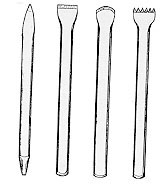 |  |
The carving on the Ludovisi Throne has been identified as being carried out with a flat chisel, as in those shown far left, and a marble drill, as shown left. |

|
On the Boston Throne evidence of the use of the running drill, left, has been found. It was probably used to divide the fingers of the central figures on the front of the relief. Details of the face and hair have been identified as being with a flat chisel, as in the Ludovisi Throne, above. No traces of the running drill have been found on the Ludovisi Throne. Unfortunately, no images of high enough quality could be found to illustrate the tool marks on the sculptures. |
| The date for the beginning of the use of the running drill has not been fixed. It is not seen on high or low reliefs until the mid 5th Century B.C., but the exact date is much debated. The running drill was also extensively used in Roman workshops, and it has been suggested that the furrows between the fingers of the character on the Boston Throne are similar to that seen on works of the Imperial Age, indicating that the Boston Throne may be a Roman copy.
However, the marks thought to be caused by the running drill could be from the drill of a restorer, or a forger. The tooling inside both thrones has been identified as being done with a heavy claw chisel, which is in keeping with the character of late Archaic or early Classical Greek Art. However, the tooling is similar, not identical in the two Thrones. This does not eliminate to Boston Throne from being the work of a forger. |